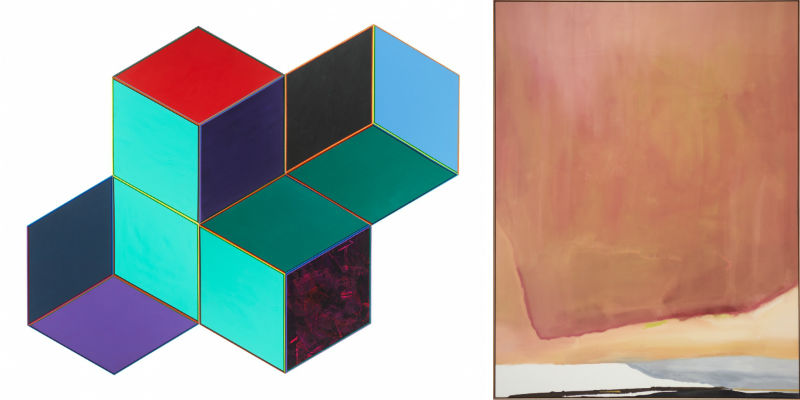Large-Scale Statements: "Abstraction, Color, and Politics in the Early 1970s" at UMMA

Right: Helen Frankenthaler, Sunset Corner, 1969, acrylic on canvas. University of Michigan Museum of Art, Museum purchase, 1973/1.813. © 2018 Helen Frankenthaler Foundation Inc. / Artists Rights Society (ARS), New York.
In the year-long exhibition Abstraction, Color, and Politics in the Early 1970s, the University of Michigan Museum of Art asks, “Can abstract art be about politics?”
The exhibition asks audiences to consider the once hotly debated status of abstract art almost 50 years later. Despite the gallery exhibiting only four pieces, the exhibition proves the abstract art of the 1970s has an ability to engage with major political themes then and now.
The move toward abstraction in art accelerated in the 1970s, and many artists turned to it in lieu of representational art. As UMMA points out, some were criticized for turning away from traditional means of representation. Critics suggested that abstract art could not be political, therefore believing artists to be intentionally disengaging with politics. At the same time, minority artists were challenging tenets of art history and institutions that promoted a specific set of standards in determining what “great art” was. Though some argued that abstraction was unable to convey political messages, the movement itself became political by deconstructing the status quo.
Christina Olsen, director of UMMA, writes that in the 1960s, African-American art was largely representational, and the broader community pushed to create uplifting imagery that promoted social and economic equality. Similarly, women artists were pushed to “degender” their work so it would not be seen as “feminine.” The turn away from representation seemed to illustrate to many critics a failure by artists to grapple with the social and political concerns of the times. But the abstract work was often interpreted by critics as “too feminine and delicate, or too angry and physical.” In this way, minority artists were in a double bind. Abstraction was already embedded in the politics of race, gender, and identity due to the broader culture at the time. The shift in artistic practice that accelerated in the latter half of the 20th century generated many debates by artists, critics, historians, and the general public about the value of art and who gets to determine what is valued.
In this exhibition, there are four works on display from prominent American artists associated with abstract art: Helen Frankenthaler, Sam Gilliam, Al Loving, and Louise Nevelson. These four large-scale works fill the gallery space and exemplify the ability of abstract art to make a statement. Olsen suggests that these “acts of staining, pouring, draping, and taking apart the wall itself [is] a means of enlarging this political and aesthetic conversation and imbuing abstraction with political, sexual, and cultural concerns.” Each artist was groundbreaking in his or her approach, leading the modern art movement toward new standards and diversity.
Al Loving’s Bowery Morning, 1971, is an expansive geometric painting on canvas. The canvas border is cut in a geometric shape and then filled in with square panes of color, creating an illusion of dimension with its flat surface. Loving was born in Detroit in 1935 and studied painting at the University of Michigan. He moved to New York in 1968 and one year later became the first African-American artist to have a one-person show at the Whitney Museum of American Art.
Sam Gilliam’s Situation VI-Pisces 4, ca. 1972, is an enormous swath of fabric (polypropylene) covered in a warm palette of synthetic polymer paint. The draped fabric is reminiscent of a curtain, or a piece of laundry hanging in the wind, which is generally cited as Gilliam’s inspiration for the groundbreaking work. Gilliam is an African-American artist from the Washington Color School. He was the first artist to explore the idea of an unsupported canvas, draping his canvases from walls and ceilings.

Sam Gilliam, Situation VI—Pisces 4, ca. 1972, polypropylene painted multiform. Williams College Museum of Art Museum purchase, Otis Family Acquisition Trust and Kathryn Hurd Fund. Courtesy of Joseph Goddu Fine Arts Inc., New York. © Sam Gilliam.
Helen Frankenthaler’s Sunset Corner, 1969, is an example of Frankenthaler’s Color Field works, the style of painting named to describe the approach. Frankenthaler was one of the originators of this movement, which includes artists Mark Rothko, Sam Gilliam, Frank Stella, and many others. Frankenthaler’s paintings were created with thin washes of color (oil paint suspended in turpentine) that soaked into the canvas, making spontaneity and chance an important part of her process.
Louise Nevelson’s Dark Presence III, 1971, is a 3-D work made from painted wood and represents the style of work for which she is most well-known. The piece on display is part of her series of “walls,” which were generally assembled from wood and found objects from the streets of New York.
These quintessential artists paved the way for contemporary art as we know it. Though it may seem that these once extreme works of art are almost unexceptional in today’s landscape, each artist was a pioneer in a time when abstract art was perceived as non-political. By pushing boundaries, artists allowed the movement to become political by refusing to conform to the established standards of the time.
Elizabeth Smith is an AADL staff member and is interested in art history and visual culture.
"Abstraction, Color, and Politics in the Early 1970s" is on display at UMMA's A. Alfred Taubman Gallery II, 525 S. State St., Ann Arbor through September 29.


































